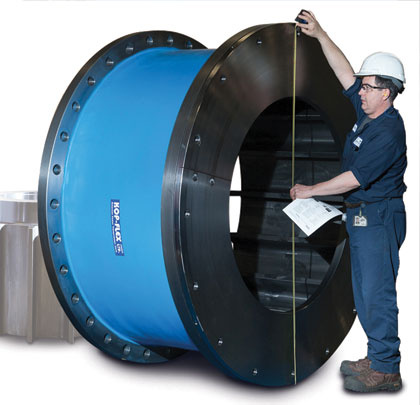In the field of coal power generation, suppliers face the problem of balancing their resources with the demands of production. Over the past few years, the emerging major trends are reliability, maintenance planning, and ease of maintenance. Process and equipment changes are expected to achieve higher product yield and improved equipment performance. Long product life is also required and expected. And, for the vast majority of coal producers, minimal down-time is essential in order to optimize production. Therefore, the coal power generation industry needs products with a high level of reliability and low maintenance requirements. It demands solutions that are easy to install and disassemble in order to minimize outages. Kop-Flex couplings offer a complete line of industry leading styles to accommodate direct drive applications, and the Kop-Flex MAX-C WB coupling is the most recent addition.
KOP-FLEX MAX-C WB COUPLING
Developed by the Kop-Flex unit of Emerson’s Power Transmission Solutions business, the MAX-C WB coupling is a new solution for managing torsional vibration in high-performance drivetrains powered by synchronous motors, variable-frequency drives, and diesel engines, or those driving reciprocating machinery or handling shock loads. Its design combines a maintenance-free, non-lubricated MAX-C resilient coupling half with a lightweight diaphragm, disc or high-performance gear coupling half, depending on the application.
Able to operate in hot, wet, gritty environments and other difficult conditions, the Kop-Flex MAX-C WB coupling can be used on synchronous and variable frequency motors, driving compressors, kiln drives, steel mill main drives, crushers, and ID and FD fans with a wide range of sizes and torque capacities, which makes it perfect for the demands of coal power generation. From a design perspective, the main difference between the WB series and other MAX-C couplings are its wedge-shaped blocks. The blocks are natural, nitrile or SBR rubber in various hardnesses and are typically custom engineered per application. Its elastomer blocks transmit high levels of torque and cushion system shock, and because it never needs lubrication it will require less maintenance than other couplings.
LOW-COST, LIGHTWEIGHT, FLEXIBLE
The design matches the advantages of a low-cost, lightweight flexible coupling half for the driven shaft, with the vibration-damping of a MAX-C coupling half on the motor end. The maintenance-free MAX-C dampens high drivetrain torque loads, while the overall design reduces weight, cost and inertia, eliminating the need for oversized and costlier drivetrain components. Various designs of the coupling are capable of transmitting up to 56,000,000 pound inches (6383 kilonewton meters) torque.
The MAX-C coupling consists of an outer sleeve with a bladed ID, an inner flex hub with bladed OD, and resilient drive blocks that fill cavities formed when the sleeve and hub are mated. The special Wedge Block cavity design formed by the blades is filled with incompressible elastomer blocks with a Shore “A” hardness of up to 80, allowing tailoring of the block compound for hardness, chemical resistance and temperature resistance. The blocks typically last five years or more and are easily replaced, which makes the coupling “like new.”
The MAX-C design is also “fail engage”: if an elastomer block fails for any reason, the coupling will briefly transmit torque through the metal-to-metal contact of the interlocking blades, which would allow the user to immediately power down the equipment in a controlled manner.
IMPROVING PERFORMANCE EFFICIENCY OF MOTOR TO PINION COUPLING
One recent success story for the MAX-C coupling shines a spotlight on its ability to safely withstand high torque loads. An OEM specified the original coupling on the pinion drive of a rotary kiln was not able to withstand the loading and unloading stresses, which along with harmonic frequencies caused the coupling to fail prematurely. Kop-Flex was able to provide a coupling solution that would meet the torque, size and misalignment requirements of the application as well as damp any transient torque conditions due to resonance and reduce any shock loading during normal kiln operation. Upon investigation of the operating data it was determined that a size #9 Max-C WB Flex Rigid Coupling with 3/16 inch (4.76 millimeter) Limited End Float would be needed to accommodate the 13 inch (330.2 millimeter) shaft and 630,250 pound inches (71.21 kilonewton meters) torque requirement.
The WB blocks reduced the shock loading during normal kiln operation and provided damping of any transient torque conditions due to resonance, thus handling and helping to minimize any shock loading in the drive train.
LEAN AND MEAN
Kop-Flex practices lean manufacturing and lean enterprise principles as part of a corporate focus on quality. Kop-Flex management champions the “lean” concept, which is reinforced company-wide through education and employee training. This philosophy focuses on identifying and reducing waste as part of the design and manufacturing process to improve lead time and delivery, increase productivity, enhance product quality and deliver long-term cost advantages to customers. ■
_________________________________________________________________________
ABOUT THE AUTHOR
Joe Corcoran is the manager of global services and training for Emerson Industrial Automation—Power Transmission Solutions. He can be reached at j.corcoran@emerson.com or 443.831.1811. Emerson Industrial Automation, a business of Emerson, is a global technology provider that enables productivity, efficiency and quality gains for customers across a spectrum of industries. For more information, visit www.emerson-ept.com.
_________________________________________________________________________
MODERN PUMPING TODAY, July 2013
Did you enjoy this article?
Subscribe to the FREE Digital Edition of Modern Pumping Today Magazine!
![]()


